What Is Tropical Fruit Meaning? Explained!
Tropical fruits are a variety of fruits that originate from the tropical regions of the world, known for their ability to flourish in hot and humid environments.
These fruits, such as mangoes, bananas, and coconuts, are renowned for their rich flavors, bright colors, and health benefits, offering a bounty of vitamins and antioxidants.
Tropical fruits are mainly grown between the Tropic of Cancer and the Tropic of Capricorn. The warm climate of these regions is ideal for the growth of a wide range of fruits that may not thrive in cooler temperatures.
These fruits are not only significant for local consumption but also play a crucial role in the economies of tropical countries through export.
Discover the vibrant world of tropical fruits, where taste, nutrition, and color converge in nature’s sweetest offerings.

Key Takeaway
Tropical Fruits: Descriptions and Nutritional Benefits
| Common Tropical Fruits | Description | Nutritional Benefits |
|---|---|---|
| Mango | Sweet, juicy, with a fibrous texture | Rich in vitamins A and C |
| Banana | Soft, creamy, and nutrient-dense | High in potassium |
| Coconut | Versatile with water, milk, and flesh | Provides healthy fats |
| Pineapple | Tangy flavor and fibrous interior | High in vitamin C |
| Papaya | Soft, buttery texture with black seeds | Contains digestive enzymes |
Defining Tropical Fruit
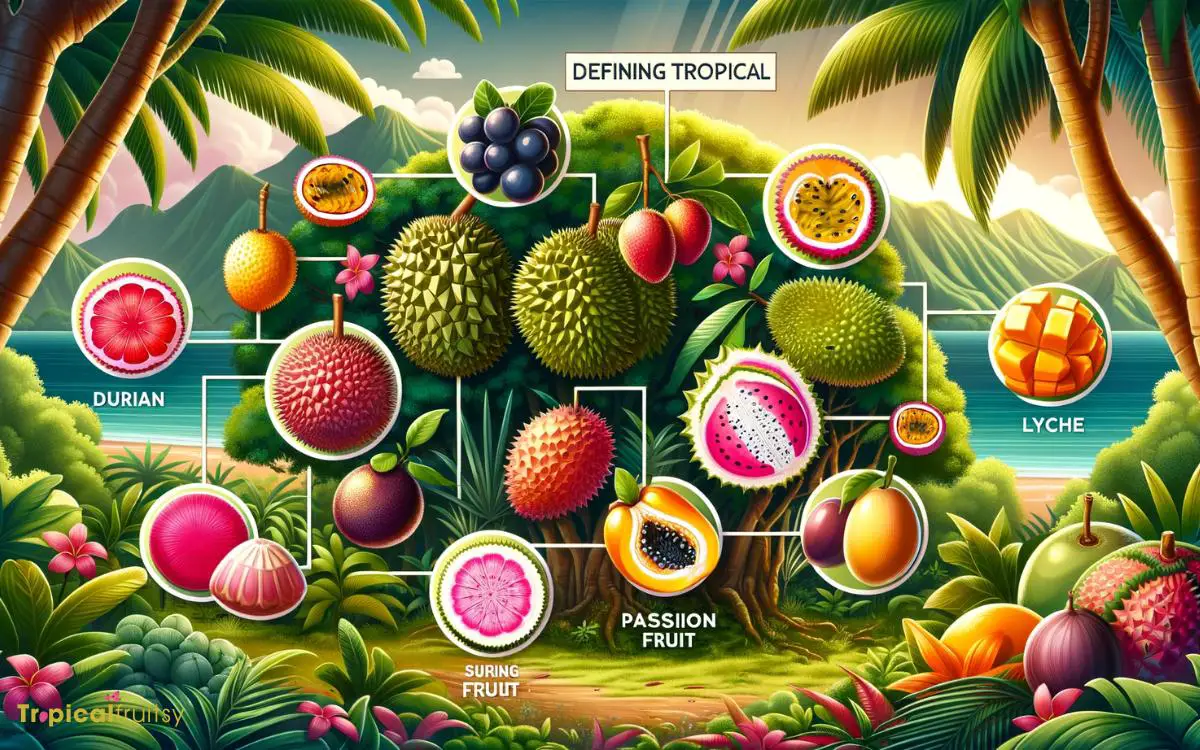
Tropical fruits are a diverse group of edible fruits that originate from regions situated between the Tropics of Cancer and Capricorn.
These fruits thrive in the equatorial belt, where conditions of high humidity and warmth are prevalent year-round.
Characterized by their exotic flavors and nutritional profiles, tropical fruits encompass species such as Mangifera indica (mango), Ananas comosus (pineapple), and Musa spp. (bananas).
Each species exhibits unique adaptations to their microclimates – for instance, the thick rind of Citrus maxima (pomelo) protects it from intense tropical sun while the porous husk of Cocos nucifera (coconut) enables it to disperse across marine environments.
Understanding the specific climatic requirements of these fruits is essential for successful cultivation. This segues into the importance of climate and growth regions in the propagation of tropical fruits.
Climate and Growth Regions
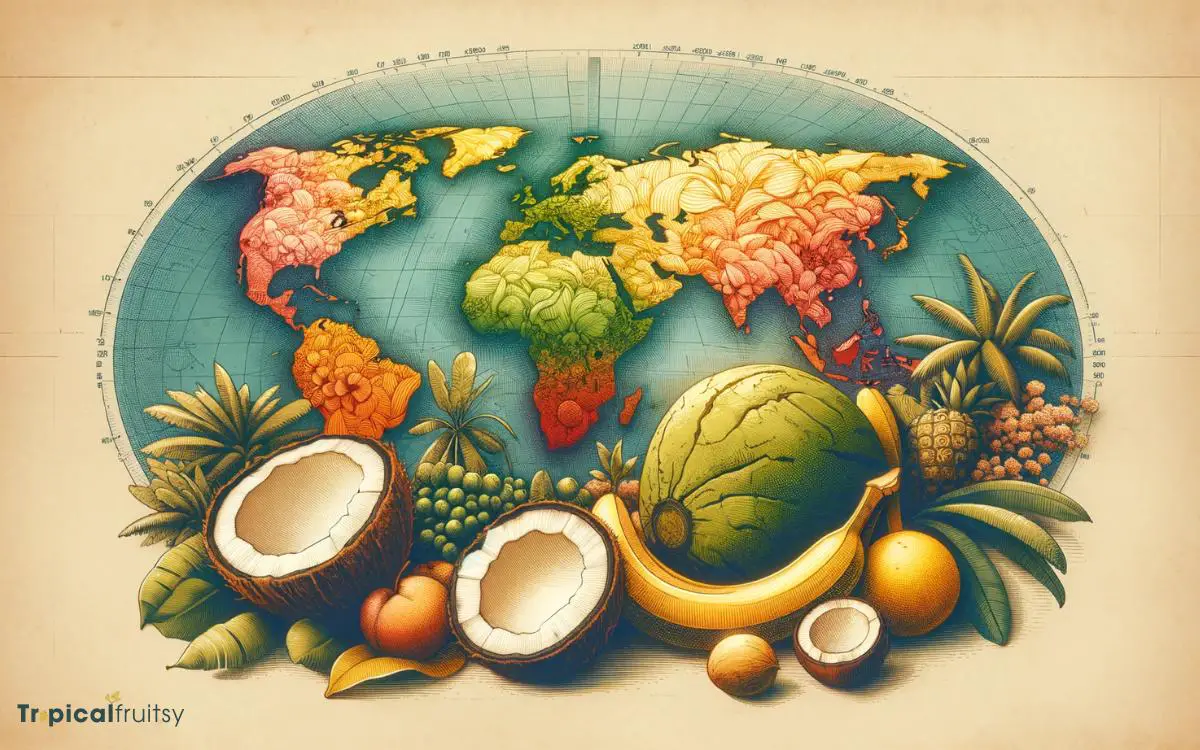
The optimal growth of tropical fruits is contingent upon the warm and humid conditions typically found within the equatorial zone.
This region, extending approximately 23.5 degrees north and south of the equator, offers a climate that is conducive to the growth of a diverse array of tropical fruit species.
These fruits thrive in an environment characterized by consistent temperatures that rarely dip below 18 degrees Celsius, high levels of precipitation, and rich, well-drained soils.
Notably, tropical fruits are predominantly cultivated in areas such as Southeast Asia, Central and South America, the Caribbean, and parts of Africa.
These regions provide the requisite agro-ecological conditions that facilitate the propagation, flowering, and fruiting of tropical species, thereby playing a pivotal role in the global horticultural economy and biodiversity conservation.
Common Varieties Explored

Among the plethora of tropical fruits, mangoes, bananas, pineapples, and papayas are some of the most widely recognized and commercially significant varieties.
These fruits are not only pivotal to dietary sustenance in tropical climates but also serve as major export commodities, influencing both local and global economies.
- Mangifera indica (Mango)
- Rich in Vitamin C and polyphenols
- Cultivars vary from the small ‘Ataulfo’ to the large ‘Tommy Atkins’
- Musa spp. (Banana)
- Source of potassium and vitamin B6
- Encompasses dessert bananas like ‘Cavendish’ and cooking bananas such as ‘Plantains’
- Ananas comosus (Pineapple)
- Contains bromelain, an enzyme with potential anti-inflammatory properties
- Propagated through crown cuttings, facilitating clonal uniformity
- Carica papaya (Papaya)
- High in papain, aiding digestion
- ‘Hermaphrodite’ trees produce commercially preferred fruit shapes
As we transition to unraveling the nutritional benefits unveiled, it is imperative to consider how these fruits contribute to health beyond their economic value.
Nutritional Benefits Unveiled
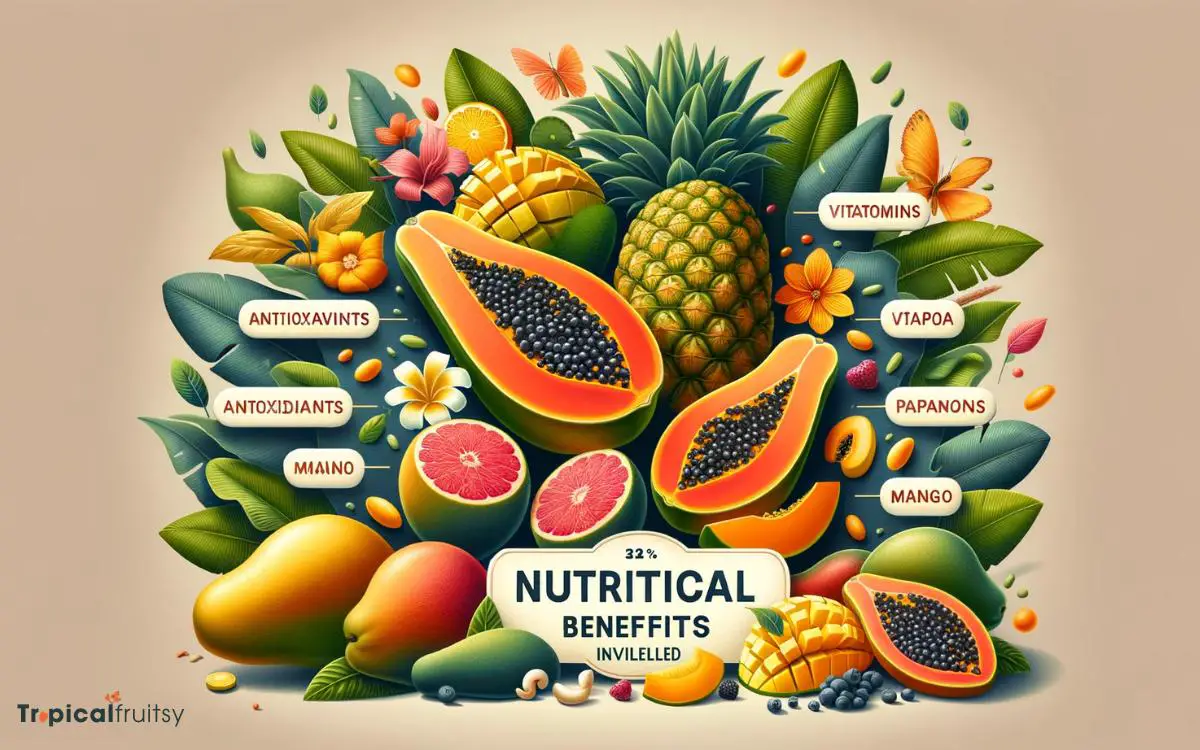
Tropical fruits are renowned for their copious amounts of essential vitamins, including but not limited to, vitamin C and various B vitamins, which are pivotal for maintaining robust immune function and metabolic efficiency.
These fruits also boast a high concentration of antioxidants—compounds that mitigate oxidative stress and have been associated with reduced risk of chronic diseases.
Furthermore, the dietary fiber present in tropical fruits is crucial for optimal digestive health, aiding in the regulation of gastrointestinal function and providing a satiety effect.
Essential Vitamins Abundance
Delving into the nutritional profile of tropical fruits reveals a rich tapestry of essential vitamins that play pivotal roles in maintaining optimal health.
These succulent botanical offerings are not just gustatory delights but also veritable founts of vital micronutrients.
For instance:
Vitamin C (Ascorbic Acid)
- Mangifera indica (Mango): A single serving provides a full day’s requirement.
- Ananas comosus (Pineapple): Renowned for its anti-inflammatory effects.
Vitamin A (Retinoids and Carotenoids)
- Carica papaya (Papaya): Contains pro-vitamin A carotenoids, instrumental in vision and immune function.
- Psidium guajava (Guava): Offers both Vitamin A and lycopene, a potent antioxidant.
Leveraging these fruits within dietary patterns can bolster physiological functions, from visual acuity to immune competency, underscoring the importance of biodiversity in nutrition.
Antioxidant Rich Content
Tropical fruits stand out for their high concentration of antioxidants, which combat oxidative stress and confer numerous health benefits.
These bioactive compounds act as scavengers of free radicals, thereby mitigating the potential for cellular damage which can lead to chronic diseases such as cancer, diabetes, and cardiovascular disorders.
Specifically, tropical fruits like mangoes, pineapples, and papayas are rich in vitamin C and vitamin E, alongside carotenoids and polyphenols.
These substances function synergistically to bolster the body’s defense mechanisms against oxidative insults.
The high antioxidant capacity of tropical fruits is conducive to the maintenance of skin integrity, the promotion of immune system efficacy, and the retardation of age-related macular degeneration, thereby underscoring their pivotal role in fostering holistic health and wellness.
Fiber for Digestion
Among the myriad nutritional benefits of tropical fruits is their substantial fiber content, which plays a critical role in digestive health.
Soluble Fiber:
- Attracts water to form a gel, which slows down digestion.
- Found in tropical fruits like mangoes and bananas, it helps regulate blood sugar levels and lower cholesterol.
Insoluble Fiber:
- Adds bulk to the stool and facilitates its passage through the gut.
- Present in fruits such as pineapples and papayas, it aids in preventing constipation and maintaining intestinal balance.
The inclusion of these fibrous tropical fruits in one’s diet can enhance gastrointestinal motility and promote a symbiotic environment for the gut microbiota, thereby fortifying the body’s natural waste elimination processes and contributing to overall digestive wellness.
Harvesting and Seasonality
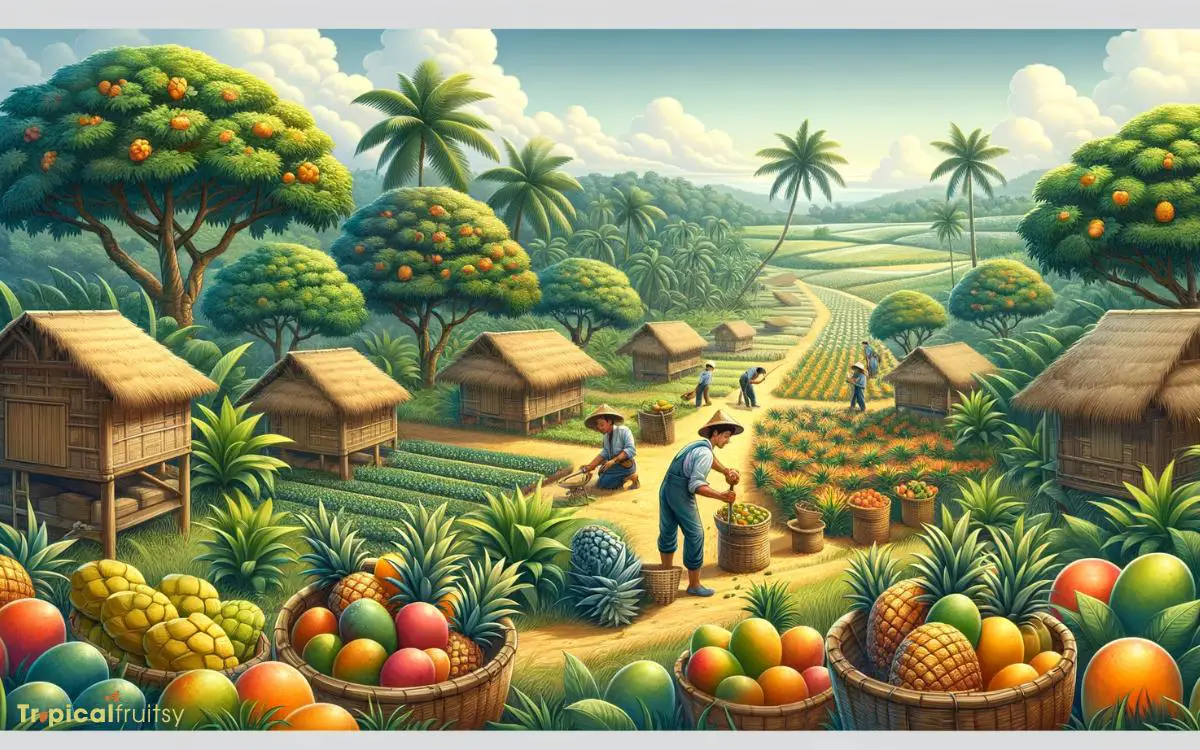
The harvesting of tropical fruits necessitates precise timing to ensure fruits are collected at peak ripeness, which is critical for optimum flavor and nutritional content.
Climatic variables such as temperature, humidity, and precipitation patterns profoundly influence the growth cycles and productivity of these species.
Consequently, understanding the seasonality of each fruit is essential for both local agricultural practices and global supply chains.
Peak Ripeness Timing
Determining the optimal time for harvesting tropical fruits is crucial, as it significantly affects their flavor, nutritional value, and shelf life.
The timing of peak ripeness varies widely among different species and is influenced by both genetic and environmental factors.
To ensure the highest quality yield, the following considerations are paramount:
Climacteric Fruits:
- Mangoes: Harvest before full ripeness; they continue to ripen post-harvest.
- Bananas: Picked when green; ethylene treatment induces ripening.
Non-Climacteric Fruits:
- Pineapples: Harvested only when fully ripe, as they do not ripen further.
- Lychees: Require precise timing; over-ripening on the tree leads to flavor loss.
Understanding the intricacies of each fruit’s ripening process is essential for growers to maximize the fruits’ marketability and consumer satisfaction.
Climate Impact Growth
Tropical fruit harvest and seasonality are significantly influenced by regional climate variations. These variations dictate the growth patterns and optimal picking times for these diverse crops.
Equatorial zones, characterized by consistent photoperiods and high humidity levels, foster year-round production cycles for certain species such as bananas and papayas.
In contrast, subtropical regions experience more pronounced seasonal fluctuations that modulate flowering and fruiting periods. This is seen with mangoes and lychees.
These fruits are often subject to a distinct harvest season, synchronized with the onset of wet or dry spells that optimize fruit development.
Understanding the meteorological nuances and ecological requirements of each species is paramount for maximizing yield and ensuring the sustainable management of tropical fruit agriculture within their respective climatic confines.
Tropical Fruits in Cuisine
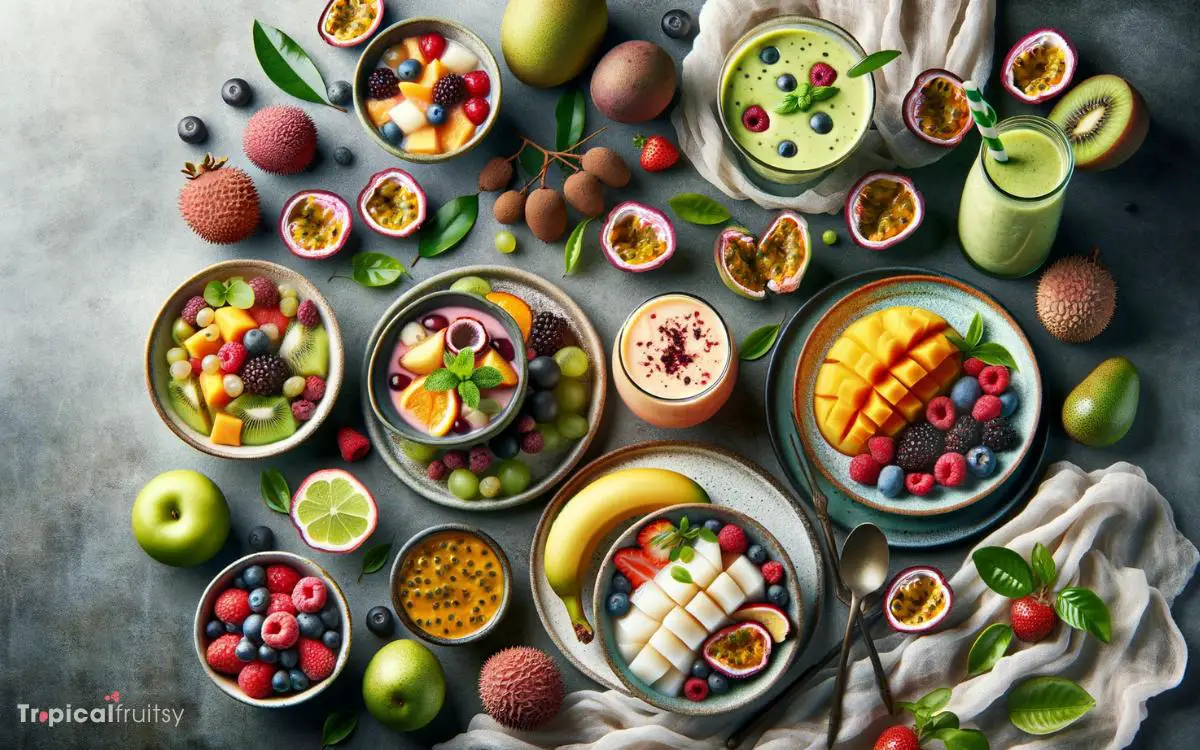
Incorporating tropical fruits into culinary practices not only enhances the flavor profile of dishes but also contributes essential nutrients and exotic appeal to global cuisines.
The use of tropical fruits is prevalent in various gastronomic traditions, offering a plethora of both gustatory and nutritional advantages.
These fruits are often rich in vitamins, antioxidants, and dietary fiber, thus promoting health alongside culinary diversity.
Utilization in Diverse Culinary Genres:
- Savory Applications: Incorporation of mangoes in chutneys, or pineapples in Caribbean stews.
- Sweet Innovations: Utilization of papaya in sorbets, or guava in pastries.
The integration of such fruits is a testament to the evolving palates and the fusion of traditional and contemporary culinary methodologies, resonating with a global audience that seeks dietary enrichment through the enjoyment of diverse flavor spectrums.
Preserving Exotic Flavors

Several methods of preservation, such as drying, canning, and freezing, are employed to extend the shelf life of tropical fruits, ensuring their exotic flavors are available year-round and beyond their natural growing seasons.
Dehydration, for instance, involves removing moisture to inhibit microbial growth and enzymatic reactions, thereby stabilizing the fruit’s integrity.
Canning, on the other hand, utilizes thermal processing to inactivate spoilage-causing microorganisms and enzymes, sealing the fruit in a sterile environment.
Freezing is yet another method where the temperature is reduced to subzero levels, dramatically slowing down biological processes.
Each technique has its own impact on the fruit’s textural and nutritional attributes, which are meticulously considered to retain the intrinsic qualities of the tropical produce for consumers in non-native regions.
What Is the Definition of a Tropical Fruit and What Fruits Are Considered Tropical?
A tropical fruit is typically grown in warm climates near the equator. These fruits are known for their sweetness and vibrant flavors. Some popular tropical fruits include mangoes, papayas, pineapples, and coconuts. If you’re looking to explore tropical fruit types, consider trying guavas, passion fruits, or dragon fruits for a unique culinary experience.
Impact on Global Trade

Amidst the complexities of international commerce, the trade of tropical fruits plays a significant role in the economic dynamics of exporting countries and the diversification of food options in importing nations.
This trade:
- Enhances bilateral trade relations
- Supports the establishment of trade agreements
- Facilitates cultural exchange through gastronomy
- Impacts biodiversity conservation efforts
- Promotes sustainable agricultural practices
- Raises concerns over genetic erosion and monocultures
The cultivation and exportation of tropical fruits such as bananas, mangoes, and pineapples contribute to the Gross Domestic Product (GDP) of many developing nations, where agriculture forms the backbone of the economy.
Conversely, the demand for year-round availability of these fruits in temperate zones influences market prices and international trade policies, necessitating a balance between economic incentives and environmental stewardship.
Conclusion
Tropical fruits, akin to nature’s kaleidoscope, offer a vivid palette of flavors, textures, and aromas, enriching global cuisine and trade.
Their cultivation and consumption not only contribute significantly to nutritional diets worldwide but also play a pivotal role in the socioeconomic dynamics of producing regions.
As embodiments of biodiversity, they challenge agronomists and ecologists to sustain and protect their vibrant presence amidst the rapidly changing environmental and economic landscapes.






